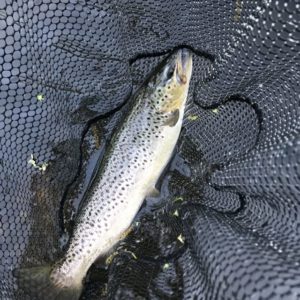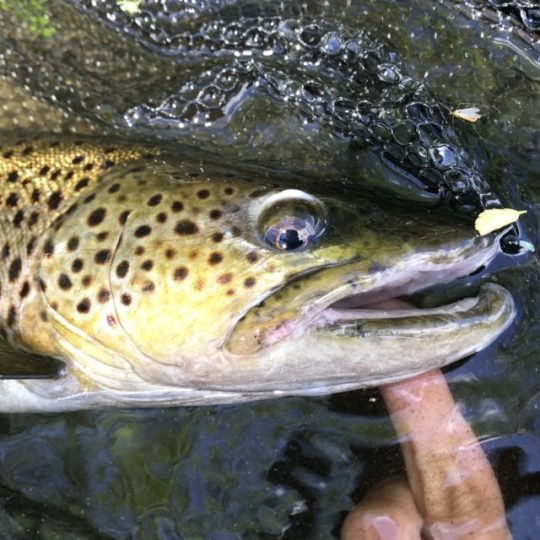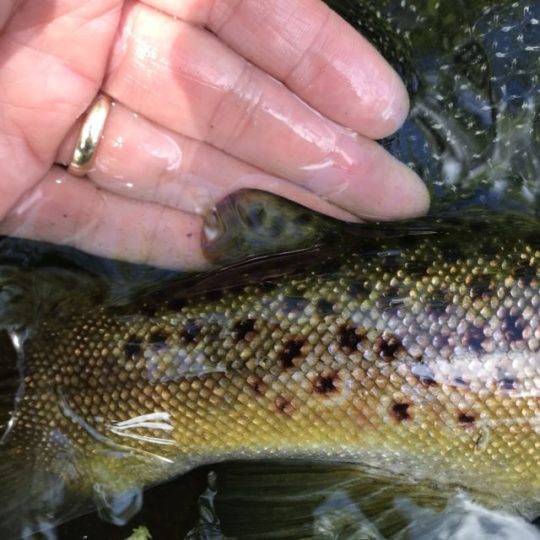Schedules worked out.
I was able to have a double-header weekend and fished five hours on Saturday and eight hours on Sunday. After all the sadness and horror I felt about George Floyd’s murder, I was grateful to hit the water. Words cannot express my anger and sorrow….
I pursued dries-or-die each morning. I’ve been hitting new spots and focused on trying to dupe trout up top. Saturday was slow, with only one take before the sun started to beat down and eliminate all the shadows along the banks. But, it was a good-sized fish that took a brown #20 Mole Fly.

I fished at achingly slow water, and it was fun to creep around to look for rises. I tried all sorts of dries as an experiment, but that Mole Fly was the only one that worked.
The fish were definitely leery. They stopped rising whenever I got closer than 40 feet. I brought with me my Orvis H2 #4 and my Sage #000. The latter wasn’t useful, as it didn’t have the range.
On Sunday, I had better luck up top. After a billion or so casts, I managed to land three fish on dries. It was incredibly fun to stalk for fish and try to throw good casts that didn’t disturb the flat water. It definitely wasn’t a high-volume game, but I felt like I had earned each fish.
I tried various dries, and the Mole Fly continued to be the most effective pattern. And, brown outshone all other colors.
Once the sun was directly overhead, all rises stopped. That’s when I switched to wet flies, targeting riffles and glides. At one spot, another angler warned me: “Three young guys just cleaned up that area while Euronymphing with worms.”
Well, I think that wins the GenZ creativity award! I had always thought that tightlining with bait would do well. But, I’m not a bait guy and have no personal interest in trying.
I fished anyways. Fortunately, this beauty showed up.
It definitely looked wild to me, with very pronounced and beautiful fins (which you can see particularly well in the second video). It taped at 19″, and I knew it was a good fish when I could feel its head shakes reverberate from the line to the rod to my casting hand. Thankfully, the knots held, and I was able to angle the rod pressure so that the tiny barbless hook didn’t pop out.
I still hope one day to join the 20/20 Club (catching a 20″+ fish on a size 20 fly). The quest continues.
I also hit some highly-pressured water for fun and right after a very talented angler tightlined the area twice. I landed a good number of fish and was surprised that wets did so well (our “how to” wet-fly guide here).
The hot wet flies included two 2020 Confidence Flies, a #20 Mighty Midge and a #20 CDC BWO Soft Hackle. I surprisingly got hits on a #14 Partridge and Yellow, a pattern that bombed for me last year.
My best wishes to everyone….
Discover more from BlogFlyFish.com
Subscribe to get the latest posts sent to your email.



Great post!
Hoping I can get your thoughts on a few things.
It sounded like you were out by yourself, I’m fairly new to fly fishing and young (22) all of my trips are solo because fly fishing isn’t something any of my friends do. I guess because I’m young I tend to get frustrated by things like messing up knots, tangles. The little things.
How do you get over disasters and dissapointment during solo trips? You mentioned “after a billion casts” you managed to land a few fish, how do you stay hopeful during slow fishing like that?
I enjoy being outside more than anything, and fly fishing is the cherry on top of it all. It may be my inexperience but those are just a few questions I had
Great questions! I hope blog readers and members of the blog team will comment, too.
My two cents:
1. Fishing with others
I think there is no substitute for fishing with others when you’re just starting.
Where are you based?
Are you near a Trout Unlimited chapter? I would join one. All the anglers I’ve met who are active in TU are incredibly thoughtful and generous. And, some chapters are modernizing. The Boston one, for example, has had an influx of younger people, and they’re using a lot of social media.
2. It takes time
Eventually, you’ll get the hang of knots and tangles. You’ll also get better calibrated. Sometimes, the fish are just not going to hit anything; e.g., it is very bright out, there is no bug activity, and a few dozen anglers have trampled over that run. So, I’ve learned not to beat up myself.
3. Timing
In the summer, on sunny days, fish will be most active at dawn and at dusk. As I read somewhere, at high noon, to a fish that is like when we drive through a major snow storm with our headlights set on high. It’s tough for them to see when conditions are very bright.
4. Online resources
I’m largely self-taught. It has been a fun journey, and, if you’re not in a rush, there’s a lot you can learn from the Orvis fly fishing videos and YouTube in general.
5. Fishing guides
They’re expensive but can be helpful.
Personally, I would avoid the Swift River. The best runs are usually occupied before dawn in the high season. I would go to a river like the Deerfield, where Chris Jackson guides, or the Farmington, where Zach St. Amand is. Dave Machowski is a fish hawk and guides at the Housatonic.
I’d also be careful as to which guides you hire. There’s nothing like word-of-mouth and personal reputation, which is why the best guides don’t hype themselves, as they’re already busy. They have a ton of repeat business.
Honestly, we need a Yelp.com for fishing guides.
Well Jo, I think you hit a lot of the important aspects. I also want to say, that I got much better when I started tying flies. And the reason was not that the fly tying directly, but how the tying made me start thinking of fish behavior, the bug life cycles, and how that interacts with the timing of day and season.
And then to reiterate most importantly, it has taken time. Not many short cuts in fly fishing. About the best one I can think of is the wooly bugger, that works just about all the dang time. If I had to choose one fly, it would be that.
I would also suggest going and finding thin blue lines were the fish are a bit more forgiving and are easier to find than you might think. Geoff of Brackish Flies and Jay ( Handmade Angler ) are also both good guides too.
Good luck out there Nicholas and great post Jo!
Great point about fly tying. When I was a rookie shopping at Concord Outfitters, I ran into another customer, who encouraged me to take up fly tying. He mentioned that it would help me be a better angler. He was right.
Your reasons for doing so really resonate, and I wish someone had told me them when I first picked up the fly rod.
And, I think fly tying helps me out with fly selection, as I now think more strategically about what might be happening at the river on that particular weather day.
Nicholas, I understand your frustrations. While I love salmonids, like you I’m far (Cambridge) from good trout ground. I’ve hooked but not landed one at the Quinapoxet over two outings this spring. I’ve had no luck other than bluegills at Walden in the past.
So to get some more on-the-water time, last season I fly-fished the Charles via kayak (using Paddle Boston’s season pass). That meant targeting bass but getting lots of bluegills & perch. This helped work through casting, knots and tangles. I’m more confident w/ the fly-angling mechanics now.
I would second trying a guide, if you can afford it.
Also, I would check out the Youtube channel for Huge Fly Fisherman. He has lots of videos aimed at not-knowledgable enough with a good sense of humor.
I am from Lynn MA, just north of Boston, which makes even getting to some rivers an adventure.
I try and practice as much as I can at home or at ponds near me, but it seems like nothing will substitute actually being out there getting real experience
The frustration kind of piles on because I have to drive an hour and a half to the Millers, 2-2 and a half hours for the Deerfield or EB. The Quinnie is the closest river to me (45 min) where I have had success.
In the grand scheme of things I know thats not alot of driving, and I dont mind it either. But it makes it a little tougher to plan a whole day out.
I’ve tried looking for guides but haven’t had much success so far, I’ll keep those suggestions in mind
A Yelp.com fly fishing guide page would do wonders
“How do you get over disasters “
You learn from them and become a better angler. Practice makes perfect.
Some days you are just all thumbs. We all experience this. We all sometimes fish in the trees instead of IN the river on our backcasts. Sometimes the wind puts a hopeless tangle in our leader. Sometimes we forget some of our equipment. (Wink, wink Jo) Some days you fall in the river. It happens. You’ll get over it.
“how do you stay hopeful during slow fishing like that? “
Because the next cast can produce a monster, the fish of a lifetime.
One quote I read lately is “God does not charge time spent fishing against man’s allotted lifetime”
So you have ALL the time in the world to work on things.
If things are slow, just sit by the river and enjoy just being there. At my age I do a lot of this.
Thank you for for the comments Bob,
Truthfully the whole reason I started to learn more about fly fishing was just to have something extra to do while I hike. To help me enjoy being outside more (not enough people my age get outside) but it ended up grabbing by my boots and turned into something I really want to excel at so my frustrations can snowball.
I do need to slow down and enjoy it too
Thanks again Bob
I have spent a lifetime flyfishing and hiking mostly out west as a means to get to the best fishing. Double the fun double the pleasure. Don’t have to hike here too far to get to the rivers. So I know what you mean about hiking.
The area im from here in Mass there are only rumors of whispers about year round trout streams.
And frankly half of them are in someones backyard or theres no good way to get there.
Being able to hike somewhere cool for awhile to fish is half the fun!
Maybe consider doing saltwater fly fishing? As you are in Lynn, you are close to some good water.
I’ve always been a freshwater fisherman, my family has a place on a lake in Maine. So that’s the kind of fishing I grew up doing, and I already had a few things for freshwater fly fishing from grandparents etc.
I have thought about going towards the salt water fly fishing, but all of my fishing knowledge is based around freshwater. Once I get confident enough with this I’ll probably venture into the salt water realm of things (whenever that may be)
I started saltwater fly fishing off a Long Island, NY barrier island seriously this May (I made token effort in the past). I was able to catch small stripers and a decent bluefish. But 1) the gear is more expensive than for freshwater (though much less so than in the past) and 2) the wind is much, much worse in most saltwater. Even a windy day on a river one can find lees in the bends; not so on most flats or surf. I still can’t get a fly out into the ocean-side surf on a windy day (>15 knot winds).